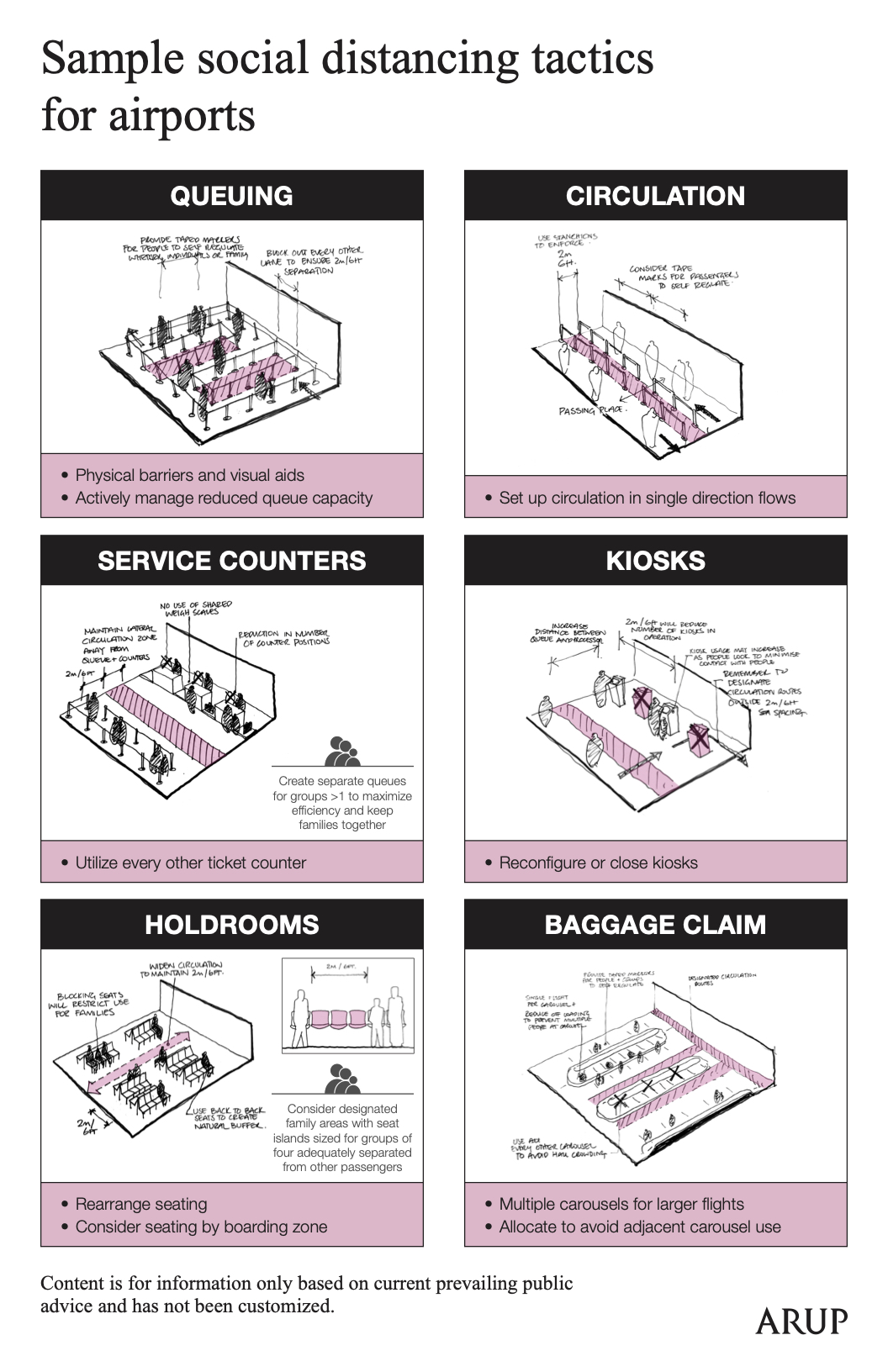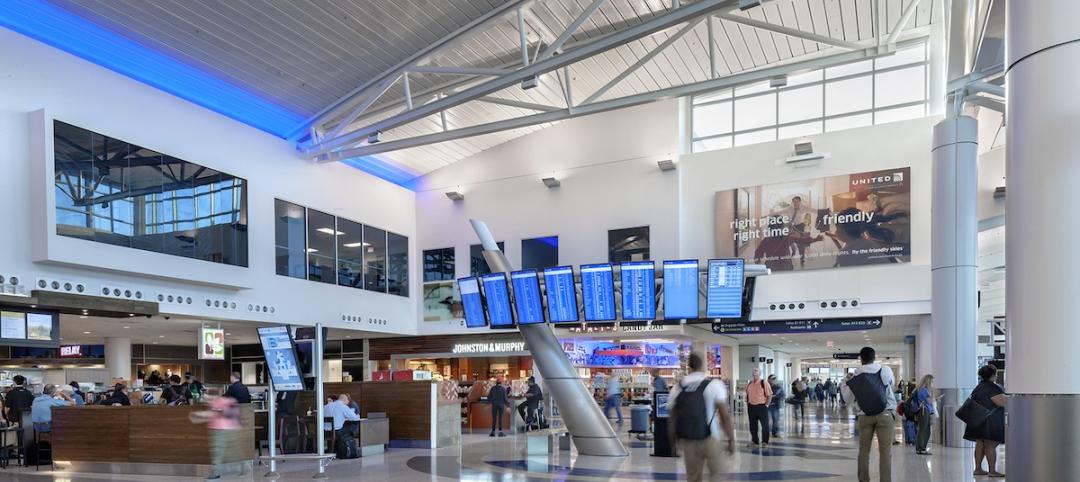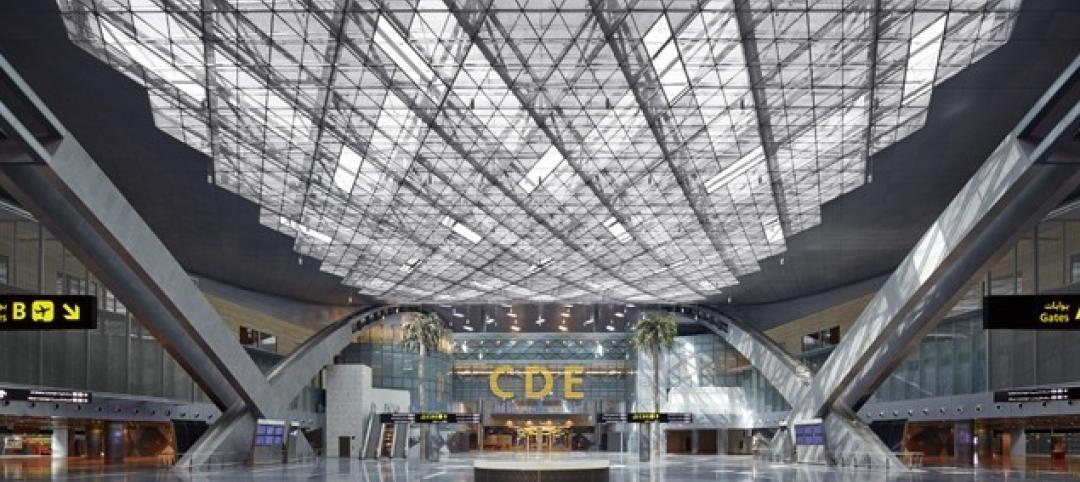The airport “experience” of hurry up and wait leaves passengers often standing virtually on top of their fellow travelers in processing, security, and boarding queues, or at baggage carousels on their way out. And unless a person is sweating profusely or coughing violently, there’s no way to know by sight the physical condition of the person next to you.
Not exactly an ideal setting for infection control. Making airports healthier for passengers and workers is daunting, and will require more than some design reconfigurations, say AEC aviation experts. And don’t expect airports to get bigger, or stay open for 24 hours, either, because neither would relieve the problem of pushing thousands of people through narrow checkpoints every couple of hours.
This situation isn’t hopeless, though. In fact, door-less restroom entrances and exits in airports are now seen as a model for many building types to reduce touching surfaces. But airports, and the AEC firms they consult with, will need to get creative about streamlining chokepoints where people gang up.
“We need to be agile and pivot our design to provide a passenger experience that aligns with new expectations for the level of service,” says Scott Gorenc, AIA, LEED AP, Experiential Design Director with Corgan’s Aviation Group in Dallas. “The ultimate goal will be to eliminate physical touch points and create a touchless process that enables passengers to take control of their experiences.”
SEE ALSO: Wings clipped, airports veer to tech to regain passenger trust
The Aviation Group has been working with HUGO, Corgan’s R&D group, to identify design solutions within the context of the coronavirus’ spread. Gorenc says this effort is data driven, as it is relying on input from focus groups, clients, and airport users. The research, he said, is focusing on three areas where airports need to make adjustments: social distancing, touchless processing, and wellness.
Corrective measures could be as straightforward as providing passengers with more access to sanitizing products. Gorenc believes the “time has come to deliver on the promise that biometric technology and automation will have on passenger processing.” Corgan is also working with outside consultants on issues like improving airports’ indoor air quality
Who’s holding the bag?
A number of AEC firms, including ZGF Architects and HOK, would like to see more airports in the U.S. adopt the European model for baggage handling that significantly reduces the number of people besides the passenger that touches bags. Sharron van der Meulen, Partner and Interior Design Practice Leader with ZGF, is convinced that RFID tags for baggage tracking will become far more common, and lead to more self-checking of luggage, which airports in Asia and Europe already allow.
Van der Meulen is a fan of automated systems at security points that speed up the process of checking carry-on bags and other personal items, where passengers don’t touch the bins for those items that go through scanners. She also spoke of “matrix screening,” where a security person would screen bags electronically from a location remote from the security point. The advantage of this, she explains, would be less distractions for scanning personnel.
 Arup has devised tactics for social distancing at several areas inside airports. The solutions rely on spacing, reconfiguring, and the occasional barrier. Source: Arup CLICK TO DOWNLOAD PDF VERSION
Arup has devised tactics for social distancing at several areas inside airports. The solutions rely on spacing, reconfiguring, and the occasional barrier. Source: Arup CLICK TO DOWNLOAD PDF VERSION
At the service of a touchless experience, mobile check-in could become more widespread, even mandatory, posits van der Meulen. Another necessary measure—taking passengers’ temperatures before they enter the airport—would be difficult at first to execute, she concedes, and might best be conducted as people debark from their rides to the airport, in the parking garage or Uber stand.
“Better utilization of the curb” to decentralize passenger processing, wrote Ty Osbaugh, AIA, LEED AP, Gensler’s Aviation Leader last March. Airports’ “new reality,” he stated, limits queuing and congregation spaces through better processing that includes “premapping” a passenger’s experience, a la Disney FastPass+ for its theme parks. Other measures for infection control—like rethinking seating layouts in boarding areas to include standing rails with charging stations and other flex options—could take more time to gain acceptance.
Osbaugh saw the “holy grail of airport safety and security” in the integration of security and biometric screening that would mostly take place in designated vestibules at the building’s entrance.
Airports will need to rely more on technology to quicken passenger movement. Matt Needham, Principal and Regional Aviation-Transportation Leader with HOK in San Francisco, says that some airports are already experimenting with facial recognition software to both hasten and bolster security. He also believes that, eventually, thermal scanners that gauge whether a passenger is feverish would be incorporated into the human screening process.
As for moving people through checkpoints, Wilson Rayfield, AIA, LEED AP, Executive Vice President–Aviation Market with Gresham Smith, suggests that rather than having areas like ticket counters or TSA checkpoints, where throngs of people gather in tight spaces, airports might consider taking a facilities-wide approach to security, similar to how casinos monitor customers at their properties via extension video surveillance.
Rayfield also believes a relaxation of security checkpoints could start with broader enrollment in the government pre-TSA program. Infection control will also be abetted, he says, by far greater use of disinfectants, sanitizers, and antimicrobial materials.
All of these measures could be good news for airport retailers because, when passengers need less time to check in, they’ll have more time to shop, says Rayfield. That’s not a trifling consideration, says HOK’s Needham, “when the airlines are talking about coming out of this crisis 25% smaller.”
Related Stories
Airports | Jul 22, 2015
MUST SEE: JFK airport taps Gensler to design terminal for animals
Pets can enjoy luxurious spa and grooming services before being transported directly to their flight from the terminal.
Airports | Jul 1, 2015
FIRST LOOK: JetBlue opens sprawling green rooftop at JFK International Airport
The 4,046-sf rooftop includes landscaped green spaces, seating for 50 people, 400-sf children’s play area, and a 400-sf dog-walk area.
Sponsored | Airports | Jun 5, 2015
Exposed glulam framework offers quiet complement to Jackson Hole airport’s mountain backdrop
A three-phase expansion and renovation, which began in 2009, nearly doubled the size of the aviation hub; the only one located in a national park
Airports | Apr 21, 2015
Trends driving airport construction
Upgrades to aviation infrastructure have not kept pace with the increase in airport traffic or even at a level sufficient to accommodate the life cycle of our many dated terminal facilities. Until now.
Airports | Feb 6, 2015
Zaha Hadid-designed terminal in Beijing will be world’s largest
The terminal will accommodate 45 million passengers per year, and will be a hub for both air and rail travel.
| Jan 2, 2015
Construction put in place enjoyed healthy gains in 2014
Construction consultant FMI foresees—with some caveats—continuing growth in the office, lodging, and manufacturing sectors. But funding uncertainties raise red flags in education and healthcare.
BIM and Information Technology | Dec 28, 2014
The Big Data revolution: How data-driven design is transforming project planning
There are literally hundreds of applications for deep analytics in planning and design projects, not to mention the many benefits for construction teams, building owners, and facility managers. We profile some early successful applications.
| Dec 28, 2014
AIA course: Enhancing interior comfort while improving overall building efficacy
Providing more comfortable conditions to building occupants has become a top priority in today’s interior designs. This course is worth 1.0 AIA LU/HSW.
| Dec 28, 2014
The future of airport terminal design: destination status, five-star amenities, stress-free travel
Taking a cue from the hospitality industry, airport executives are seeking to make their facilities feel more like destinations, writes HOK's Richard Gammon.
| Dec 15, 2014
HOK-designed Anaheim Regional transit hub opens, expected to serve three million per year
ARTIC’s flexible design ensures that it can serve as a southern terminus for California’s future high-speed rail system.















